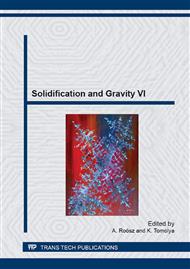[1]
D. G. McCartney: Grain refining of aluminium and its alloys using inoculants, Int. Mater. Rev. 34 (1989) 247-260.
DOI: 10.1179/imr.1989.34.1.247
Google Scholar
[2]
R.K. Trivedi: Microstructure characteristics of rapidly solidified alloys, Mater. Sci. Eng. A 178 (1994) 129-135.
Google Scholar
[3]
M.C. Flemings: Behavior of metal alloys in the semisolid state, Metall. Trans. A 22 (1991) 957-981.
DOI: 10.1007/bf02661090
Google Scholar
[4]
G.J. Eskin: Ultrasound treatment of Light Alloy Melt: Gordon and Breach, Amsterdam, (1998).
Google Scholar
[5]
E.O. Hall: The Deformation and Ageing of Mild Steel, Proc. Phys. Soc. London 64B (1951) 747-753.
Google Scholar
[6]
J.C. Li and Y.T. Chou: The Role of Dislocations in the Flow Stress Grain Size Relationships, Met. Trans. 1 (1970) 1145-1159.
DOI: 10.1007/bf02900225
Google Scholar
[7]
T.M. Yue, H.U. Ha and N.J. Musson: Grain size effects on the mechanical properties of some squeeze cast light alloys, J. Mat. Sci. 30 (1995) 2277-2283.
DOI: 10.1007/bf01184573
Google Scholar
[8]
J. Waldman, H. Sulinski and H. Markus: The Effect of Ingot Processing Treatments on the Grain Size and Properties of AI Alloy 7075, Metall. Trans. 5 (1974) 573-584.
DOI: 10.1007/bf02644652
Google Scholar
[9]
T.E. Quested: Understanding mechanisms of grain refinement of aluminium alloys by inoculation, Mater. Sci. Techn. 20 (2004) 1357-1369.
DOI: 10.1179/026708304225022359
Google Scholar
[10]
B.S. Murty, S.A. Kori and M. Chakraborty: Grain refinement of aluminium and its alloys by heterogeneous nucleation and alloying, Int. Mat. Rev. 47(1) (2002) 3-29.
DOI: 10.1179/095066001225001049
Google Scholar
[11]
W.D. Griffiths and D.G. McCartney: The effect of electromagnetic stirring during solidification on the structure of A1-Si alloys, Mat. Sci. Eng. A 216 (1996) 47-60.
DOI: 10.1016/0921-5093(96)10392-0
Google Scholar
[12]
M. Medina, Y. Du Terrail, F. Durand and Y. Fautrelle: Channel Segregation during Solidification and the Effects of an Alternating Traveling Magnetic Field, Metall. Mater. Trans. B 35 (2004) 743-755.
DOI: 10.1007/s11663-004-0014-8
Google Scholar
[13]
P.A. Nikrityuk, K. Eckert and R. Grundmann: A numerical study of unidirectional solidification of a binary metal alloy under influence of a rotating magnetic field, Int. J. Heat Mass Transfer 49 (2006) 1501-1515.
DOI: 10.1016/j.ijheatmasstransfer.2005.08.035
Google Scholar
[14]
S. Kojima, T. Ohnishi, T. Mori, K. Shiwaku, I. Wakusagi and M. Ohgarni: Development of Megnetic-stirring System in Bloom-caster, Proc. of the 66th Steelmaking Conf., Atlanta, ISS-AIME, 1983, Warrendale: 127-131.
Google Scholar
[15]
S. Eckert, P. A. Nikrityuk, D. Räbiger, K. Eckert and G. Gerbeth: Efficient Melt Stirring Using Pulse Sequences of a Rotating Magnetic Field: Part I, Metall. Mater. Trans. B 38 (2007) 977-988.
DOI: 10.1007/s11663-007-9096-4
Google Scholar
[16]
B. Willers, S. Eckert, P.A. Nikrityuk, D. Räbiger, J. Dong, K. Eckert and G. Gerbeth: Efficient Melt Stirring Using Pulse Sequences of a Rotating Magnetic Field: Part II, Metall. Mater. Trans. B 39 (2008) 304-316.
DOI: 10.1007/s11663-008-9126-x
Google Scholar
[17]
Y. Takeda: Development of an ultrasound velocity profile monitor, Nucl. Eng. Design 126 (1991) 277-284.
Google Scholar
[18]
S. Franke, H. Lieske, A. Fischer, L. Büttner, J. Czarske, D. Räbiger, S. Eckert, Two-dimensional ultrasound Doppler velocimeter for flow mapping of unsteady liquid metal flows, Ultrasonics 53, Issue 3, (2013) 691-700.
DOI: 10.1016/j.ultras.2012.10.009
Google Scholar


